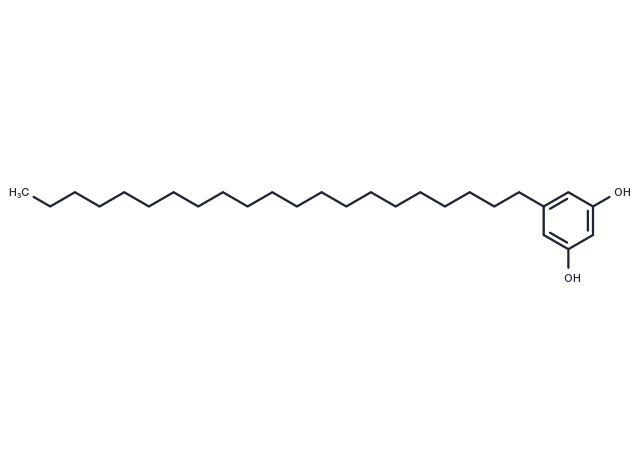Powder: -20°C for 3 years | In solvent: -80°C for 1 year


5-Heneicosylresorcinol shows inhibitory effects on the release of β-hexosaminidase from RBL-2H3 cells, it also prevents triglyceride accumulation in 3T3-L1 cells. 5-Heneicosylresorcinol has nematicidal activity against nematodes Panagrellus redivivus, Caenothabditis elegans and Bursaphelenchus xylophilus, with ED50 values of 80, 30, and 180 ug/mL, respectively.

| Pack Size | Availability | Price/USD | Quantity |
|---|---|---|---|
| 1 mg | 35 days | $ 240.00 | |
| 5 mg | 35 days | $ 1,070.00 | |
| 10 mg | 35 days | $ 1,610.00 |

| Description | 5-Heneicosylresorcinol shows inhibitory effects on the release of β-hexosaminidase from RBL-2H3 cells, it also prevents triglyceride accumulation in 3T3-L1 cells. 5-Heneicosylresorcinol has nematicidal activity against nematodes Panagrellus redivivus, Caenothabditis elegans and Bursaphelenchus xylophilus, with ED50 values of 80, 30, and 180 ug/mL, respectively. |
| In vitro | Alkylresorcinols are phenolic lipids present at levels of 0.03-0.15% in wheat and rye grains and almost 10 times higher in respective bran products. Despite numerous studies on the influence of dietary fibers on the regulation of energy metabolism, this issue still remains controversial. METHODS AND RESULTS: The objective of our current studies was to investigate whether 5-n-alk(en)ylresorcinols, natural phenolic components of high fiber human diets, may be considered as natural regulators of excessive fat accumulation. Our studies revealed that 5-n-alk(en)ylresorcinols isolated from wheat and rye bran inhibit glycerol-3-phosphate dehydrogenase, the key enzyme in triglyceride synthesis in adipocytes, specifically and effectively. Further in vitro studies showed that these compounds also prevent triglyceride accumulation in 3T3-L1 cells. CONCLUSIONS: The most effective compound in both systems was 5-n-heneicosylresorcinol(5-Heneicosylresorcinol). The results indicate that the potential to prevent triglyceride accumulation increases with the hydrophobicity of the phenolic inhibitor. |
| Molecular Weight | 404.67 |
| Formula | C27H48O2 |
| CAS No. | 70110-59-7 |
Powder: -20°C for 3 years | In solvent: -80°C for 1 year
You can also refer to dose conversion for different animals. More
bottom
Please see Inhibitor Handling Instructions for more frequently ask questions. Topics include: how to prepare stock solutions, how to store products, and cautions on cell-based assays & animal experiments, etc.
5-Heneicosylresorcinol 70110-59-7 Immunology/Inflammation Microbiology/Virology NADPH-oxidase Antifection cereals Inhibitor microscale amended medium assay Fusarium oxysporum antifungal Fungal 5 Heneicosylresorcinol supervised metabolite profiling 5Heneicosylresorcinol inhibit inhibitor
